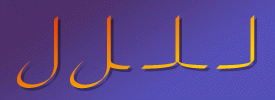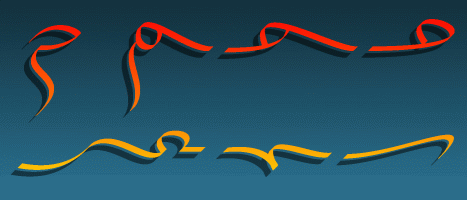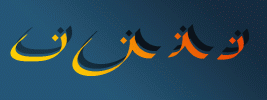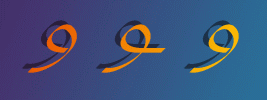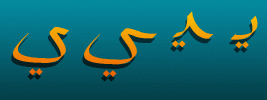
Since this page
is under construction, the pictures showing how to write the character
when you put your mouse on them will be marked (*)
The next character
is Lam (above), it's less distinctive than the kef
(it can easily
be mistaken for an alef by inexperienced readers).
The next character
has a number of possible shapes that you
may encounter,
the picture below gives an idea
The name of this
character is Meem; the upper line in the picture
shows the conventional
shapes (from right to left: initial, intermediate, final and solo)
The bottom line
shows a few less conventional (yet quite abundant)
initial, intermediate
(check out the Prophet's (p.b.u.h.) name) and final shapes.
The next character
is Noon (above), note that the final shape in
most cases protrudes
underneath the line.
This one is called
He`, as you can see it has two completely different
intermediate variations.
Next comes Wow,
sometimes it is used for W and sometimes for O.
As you can see
it is never connected to it's left.
The last character
in the Arabic alfabet is Ya.
But, it's not
over yet!
As you watch this
alfabet closely, you'll notice that practically all
characters represent
consonnants.
Only Alef, Wow
and Ya sometimes represent vowels.
These however,
are long vowels.
For the short
vowels, the Arabic uses a different system, as we will see now:

The above picture
shows the so called "tashkil", these are used
to represent the
short vowels.
You use them by
writing them above the preceeding character: the
character which
is supposed to preceed the short vowel.
From right to
left the first three represent "a`" (fatha),
"i`" (sometimes
also "e`") (kasra), "u`" (or "o`") (damma).
As you can see
there are two shapes of sukun, they both mean that there is
no short vowel
to follow,
(like in "cardoor"
you would use a sukun with the "r" in "car").
The shadeh is used
to indicate a double consonnant:
(like in "running"
in arabic you would write "runing" with
a shadeh on top
of the "n").
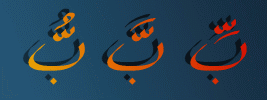
When a shadeh is
used in combination with a fatha, kasra or damma, you write
these above or
below the shadeh (and not the character).
Unfortunately,
tashkil are only used in Qur`ans, schoolbooks, poetry and in
spots where, to
arab readers, it is unclear which vowel should be used.
Another thing that
you may encounter is so called "nunation" (see picture below),
it has to do with
undetermined genetives (in which case you use
the double kasra
-right- pronounced as "in"),
undetermined accusatives
(you use the double fatha -middle- "an") and
undetermined subjects
(you use the tailed damma -left- "oon")
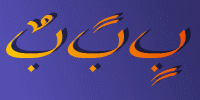
A nice example
can be seen in picture at the top of my arabic page, where the
double fatha represents
the sounds: "ahlan
wa sahlan"
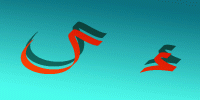
The two characters
in the picture above are the so called Alef-maqsura,
(also called Alif-leina)
on the left, and the Hamze on the right.
The Hamze is never
written in any western language, allthough it's as common
there as it is
in Arabic.
The Hamze represents
the soft sound you make deep in your throat at the
beginning of many
words that start with a vowel.
For an experiment
you can pronounce the words "it", "or", "as" and observe
what is happening
in your throat.
The Alef-maqsura
is an "aa"-sound at the end of a word that is connected to the
word by a Hamze,
instead of Hamze-Alef, the Alef-maqsura (that looks like a Ya
without dots underneath
it), is used.
The next characters
(in the picture below) are used frequently
but have no special
meaning

They are combinations
of Lam with other characters.
The three on the
right are so called Lam-Alef, they all represent the sound "la".
Of the three,
only the rightmost one can be connected to its right, but.
never to its left.
The other two are used "solo" only.
Sometimes you'll
see Lam written on top of Ha` and on top of Meem (leftmost).
Mainly this is
done in calligraphies and sometimes to save some space.
Last, but not least
in our lesson comes a special character
that is used in
feminine words only:

It is called the
Ta`-marbuta or "female Ta`".
It is called "marbuta"
because both ends are connected at the top.
On the left you
can see the final shape, on the right the solo shape (which is used
after characters
like Alef, Dal and Ra` that are not connected to their left).
Tell us what you
think about this "course":
Do you like it?
Do you have any
questions regarding it?
Let me (or a friend) know through one of these:
